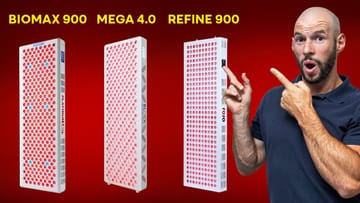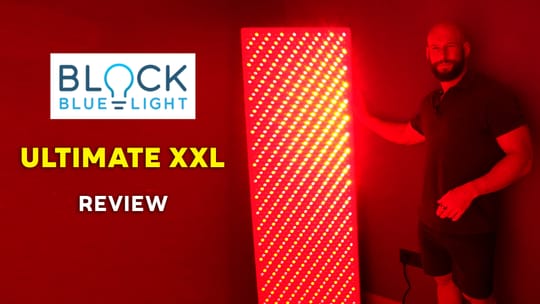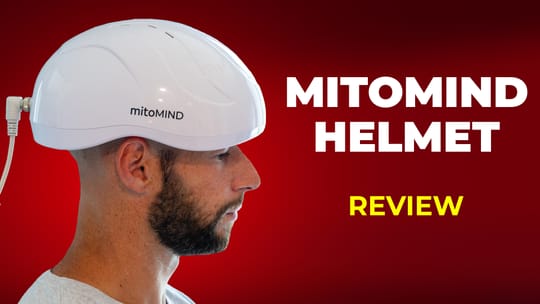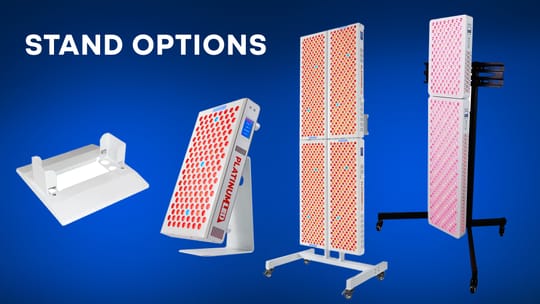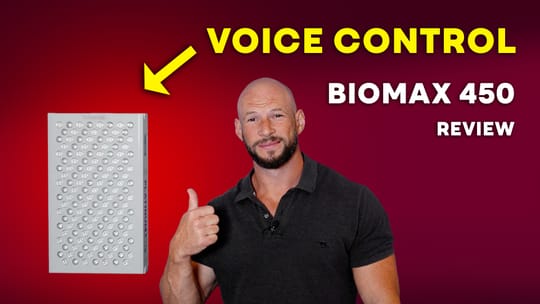Unveiling the Latest Advancements in Red Light Therapy
Hey there, fellow wellness enthusiasts! Today, I'm stoked to dive deep into the world of red light therapy and explore the groundbreaking features of the brand new eighth-generation PlatinumLED BioMax 900.
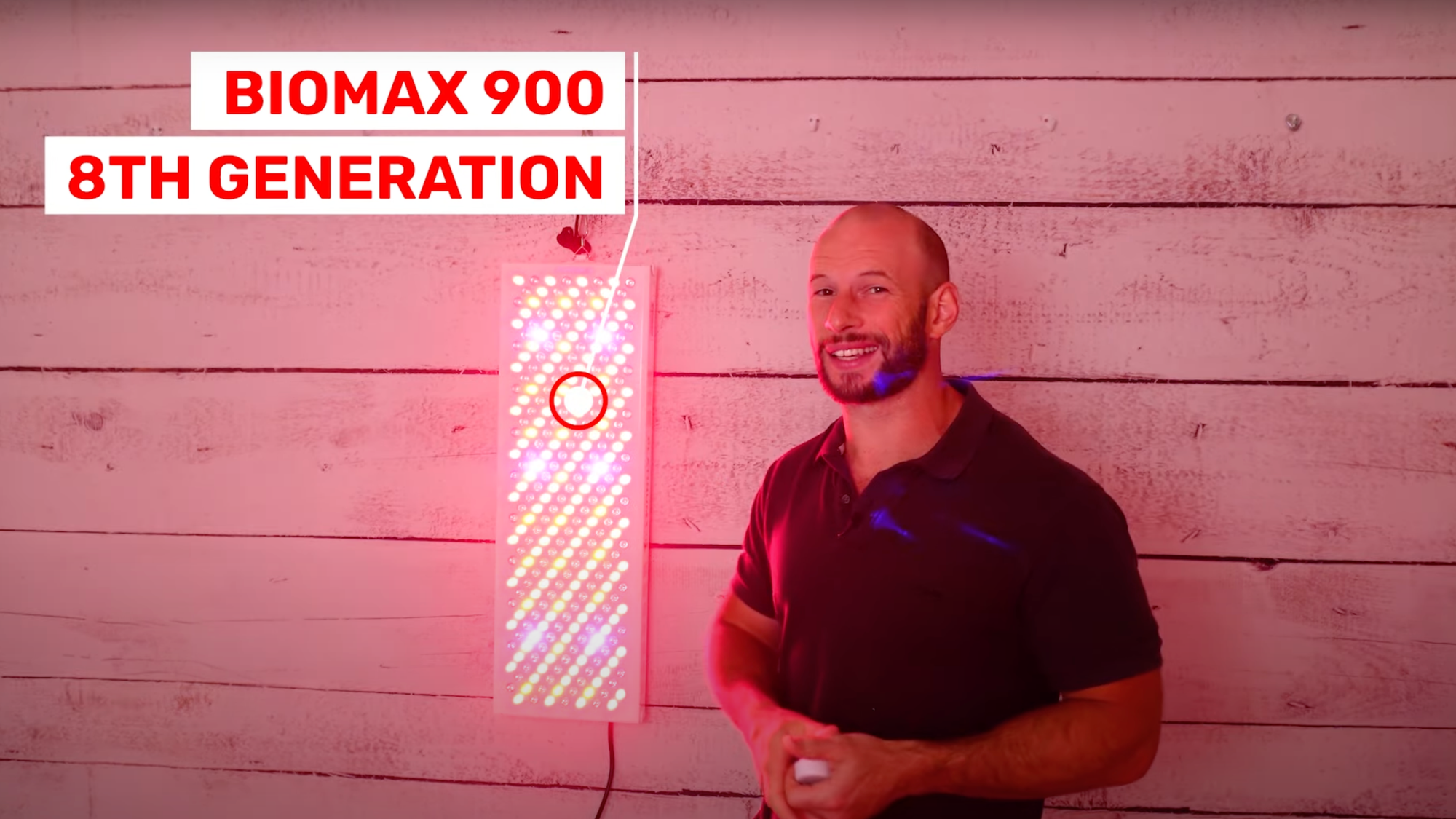
While I affectionately dub it the 2024 version, it hit the shelves in late 2023, technically. Get ready to be wowed, because this iteration brings some jaw-dropping changes, accompanied by power readings that'll knock your socks off!
PlatinumLED and the Evolution of Red Light Panels
Before we plunge headfirst into the nitty-gritty of this cutting-edge device, let me give you a quick rundown. PlatinumLED BioMax is a classic original in the red light therapy game, with 13 years of experience under their belt.
They've churned out a ton of panels over the years, and this eighth-gen gem is a testament to their dedication and innovation. They are clearly leaders in ultra-high power light therapy panels.
As someone who's passionate about red light therapy, I've had the pleasure of putting the BioMax panels through the wringer, and PlatinumLED has consistently knocked it out of the park. In fact, BioMax has come out number one in some of my comparison series.
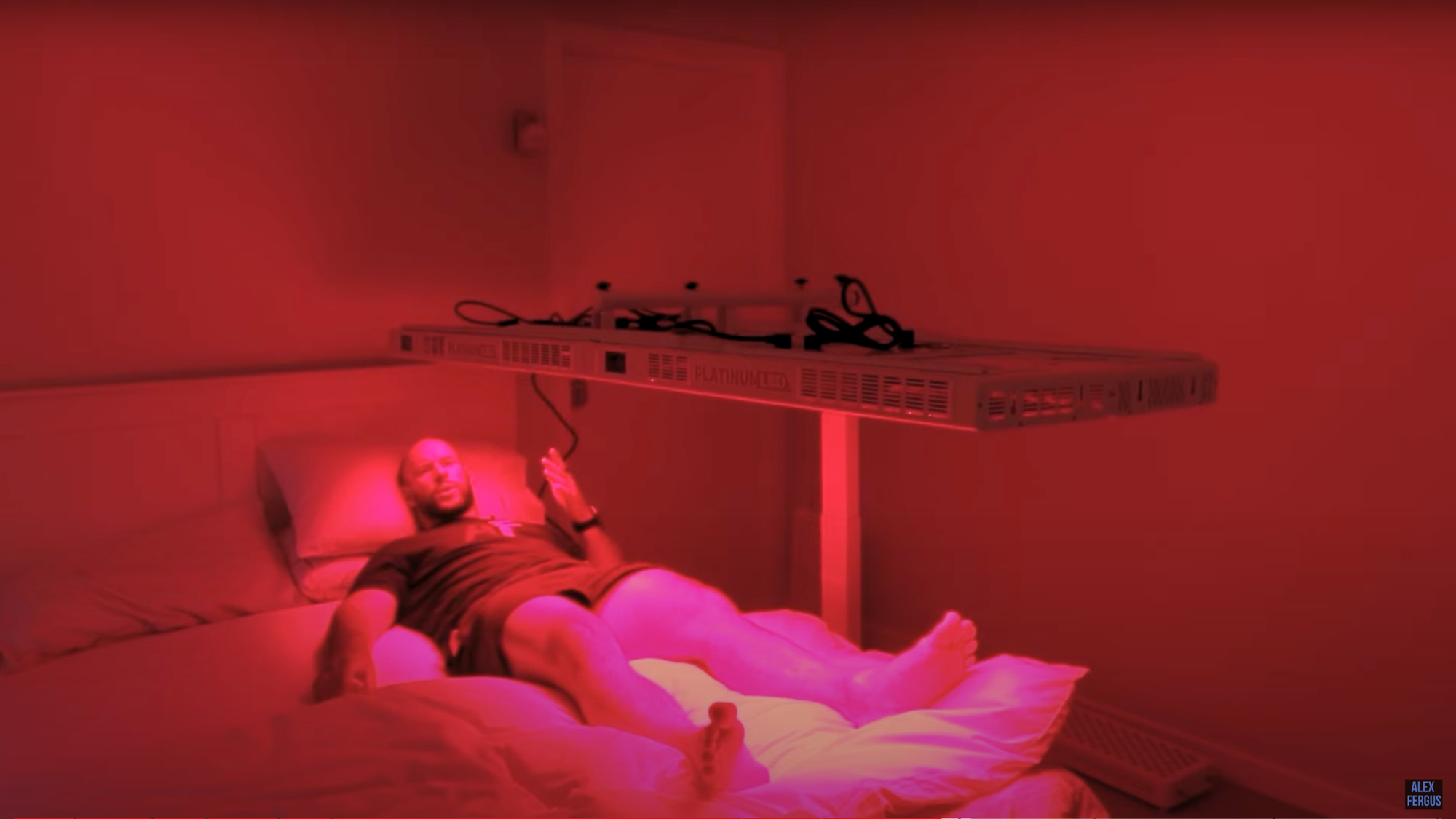
I personally use PlatinumLED BioMax 900 panels in my home setup, and I've had great results with them! So, without further ado, let's dive right in.
Exploring New Wavelengths and Enhanced Features
Now, let's get down to brass tacks: the review of the PlatinumLED BioMax 900 8th generation. What's the scoop on this innovative tech?
Well, for starters, PlatinumLED has once again upped the ante by introducing a brand-spanking new wavelength into the mix. There's a whopping seven wavelengths jam packed into this cutting-edge panel. If variety is the spice of life, PlatinumLED is spicing things up alright!
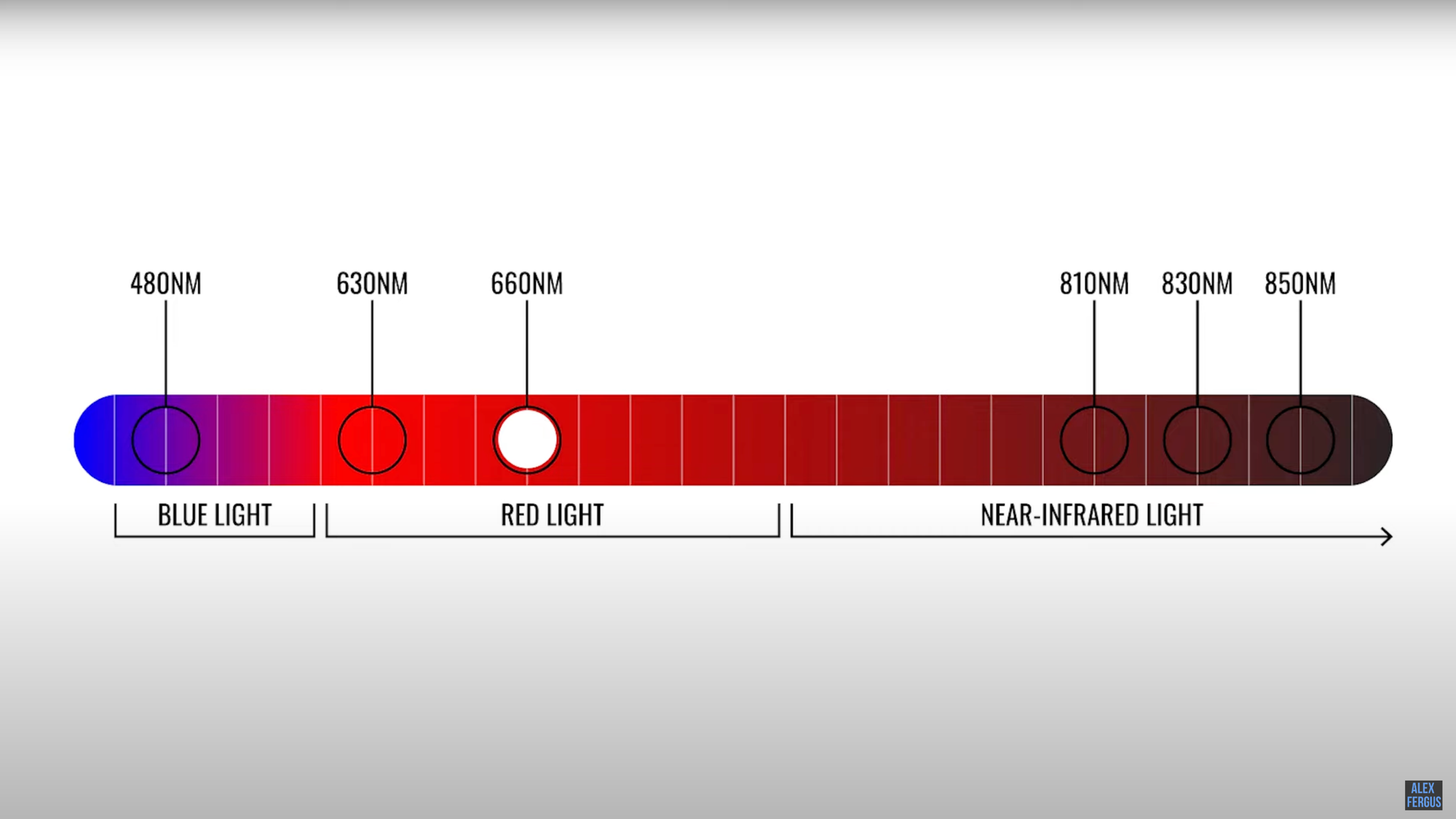
Here's the kicker—its newest wavelength is like nothing you've seen before in a panel. More on that juicy tidbit coming up. But wait, there's more!
Alongside the new wavelength, PlatinumLED has rejigged the power distribution within the panel. While the blue light introduced in their 7th generation in early 2023 is still hanging around, it's only taking up a modest 2% of the pie. Hang with me here and, I'll break down the power distribution.

Here we are 12 months after that jaw-dropping addition, and PlatinumLED has done it again. They've released a suped-up panel with a cool new wavelength. So, BioMax 900 now boasts seven different wavelengths in this panel.
That's extraordinary because it was only a couple of years ago where if a panel had more than the two traditional wavelengths of 660nm and 850nm, it was something to write home about.
Not only does it boast seven wavelengths, but its newest is one that no other company has incorporated into their panels yet to my knowledge. I know you can get devices with this wavelength, but I haven't seen it incorporated into a panel. So, I'm keen to get into that more in just a bit.
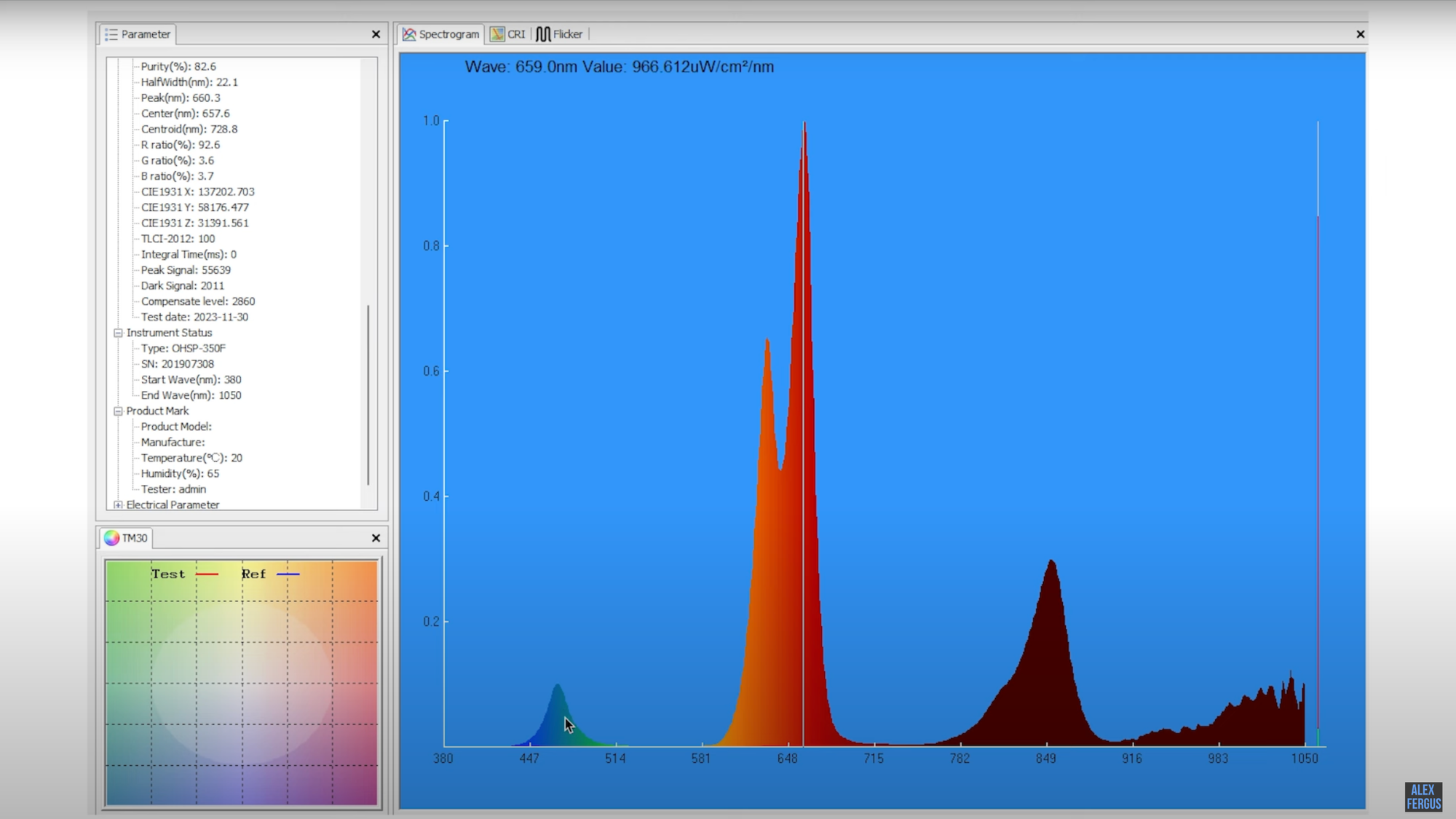
You'll notice that way over on the left is a little blue bump of light in the mid to high 400s coming from a blue-generating diode. It was pretty tricky for me to capture this reading for you showing all 7 wavelengths since each lens bulb on the panel has a single diode chip emitting one wavelength.
My spectrometer was closer to a red light to get that screenshot. Had I been centered over a different bulb, its peak would have been most prominent. As an aside, my spectrometer seems to struggle somewhat to give precise readings on wavelengths above 950nm.
A shift is taking place in the light therapy space, and PlatinumLED is keeping pace. They're even ahead of the game by breaking out new wavelengths every chance they get. It's crazy in a good way!
Yet rest assured, you'll still be getting a ton of 660 and 850 nm which are the two traditional wavelengths that kicked off the whole red light therapy scene and convinced me light therapy is helpful.
Unveiling Enhanced Power Output
One of the most eagerly awaited features of the PlatinumLED BioMax 900 8th (click the link for a discount) generation is its power output.
If you've seen my previous reviews, you will know that previous versions of BioMax 900 were so intense that if you connected them together like I have done with my quad setup of four BioMax 900 panels clustered together, the power draw was so high that it could trip the fuse box circuit board!
To prevent that from happening, PlatinumLED had to reduce its power to adapt to the circuitry restraints of their customer's homes, so the largest and widest panel in the BioMax range, was actually being throttled up until now.
Believe it or not, the smaller version BioMax 600, had been putting out more pure red light therapy than its big brother BioMax 900. Of course, that was a temporary solution.
PlatinumLED swooped in to save the day by removing those limiting restrictions with their newest 900 model that breaks free of those past constraints when used by itself. Now, when you're flying solo with this panel, you'll get the full raw unbridled power treatment!
No worries though because it won't trip the breaker box either even when it's used in conjunction with other panels since it's being kept in check when used as part of a multi-panel setup.
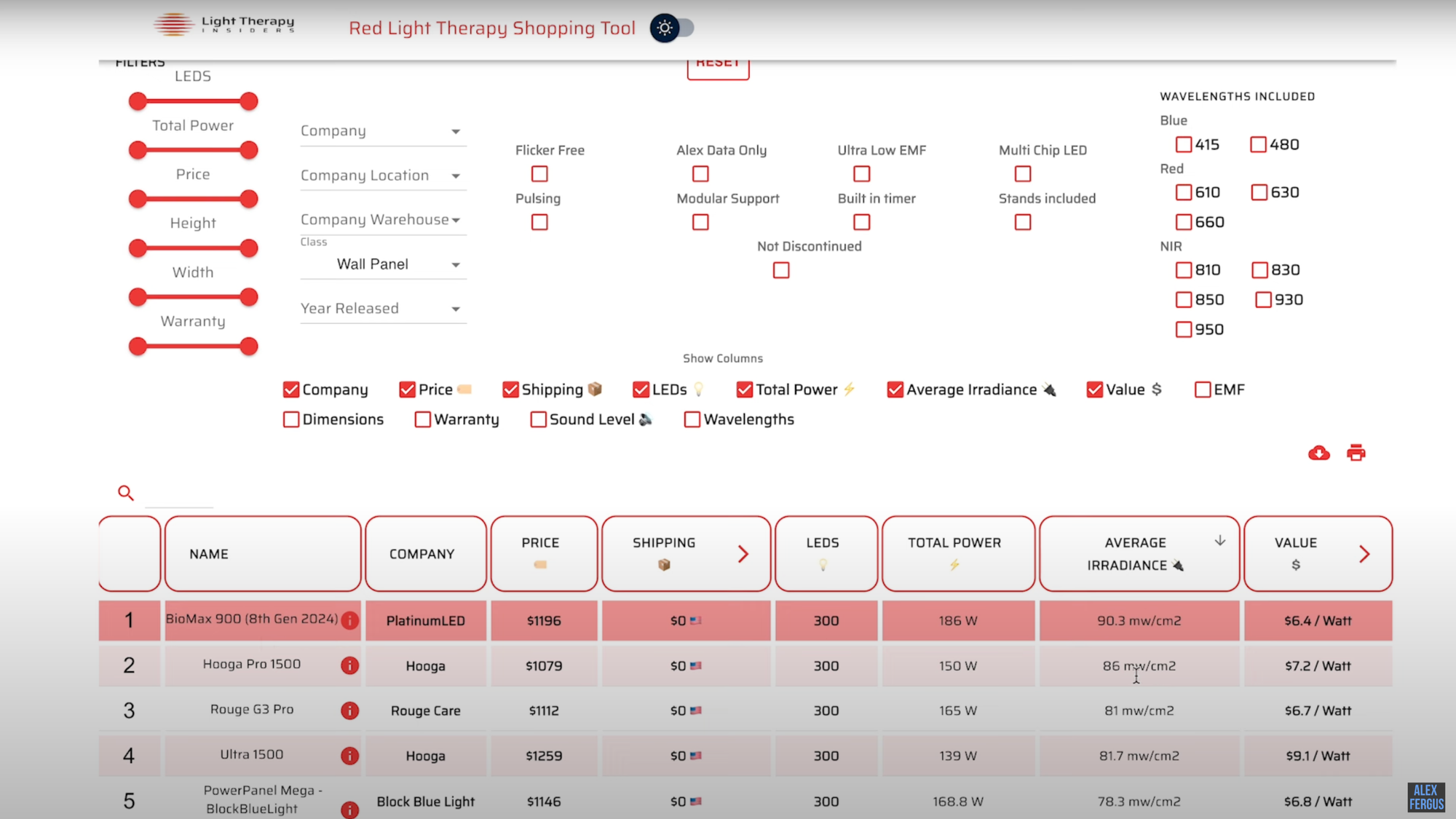
You can see the specs here on my spiffy Shopping Tool. Get a load of the juice pumping out of it when used as a stand-alone panel. It's exciting that each new development builds on its history to improve this tried-and-true panel for you.
A Closer Look at Additional Updates and Features
As we continue our deep dive, let's shine a spotlight on some other cool changes in this iteration. Surprisingly, they switched up the panel-hanging system.
This one caught me off guard because it's a blast from the past. They've gone back to their roots with the easy-breezy bracket and ratchet rope pulley system. Remember the chain link in their latest version? Well, that was a short-lived system.
Fans of the classic bracket-ratchet with a hook setup will be chuffed to see it's been brought back for the future because it helps to raise and lower the panel which makes for convenient installation. With the easy height adjustments, you can treat your back and then lower it to treat your legs.
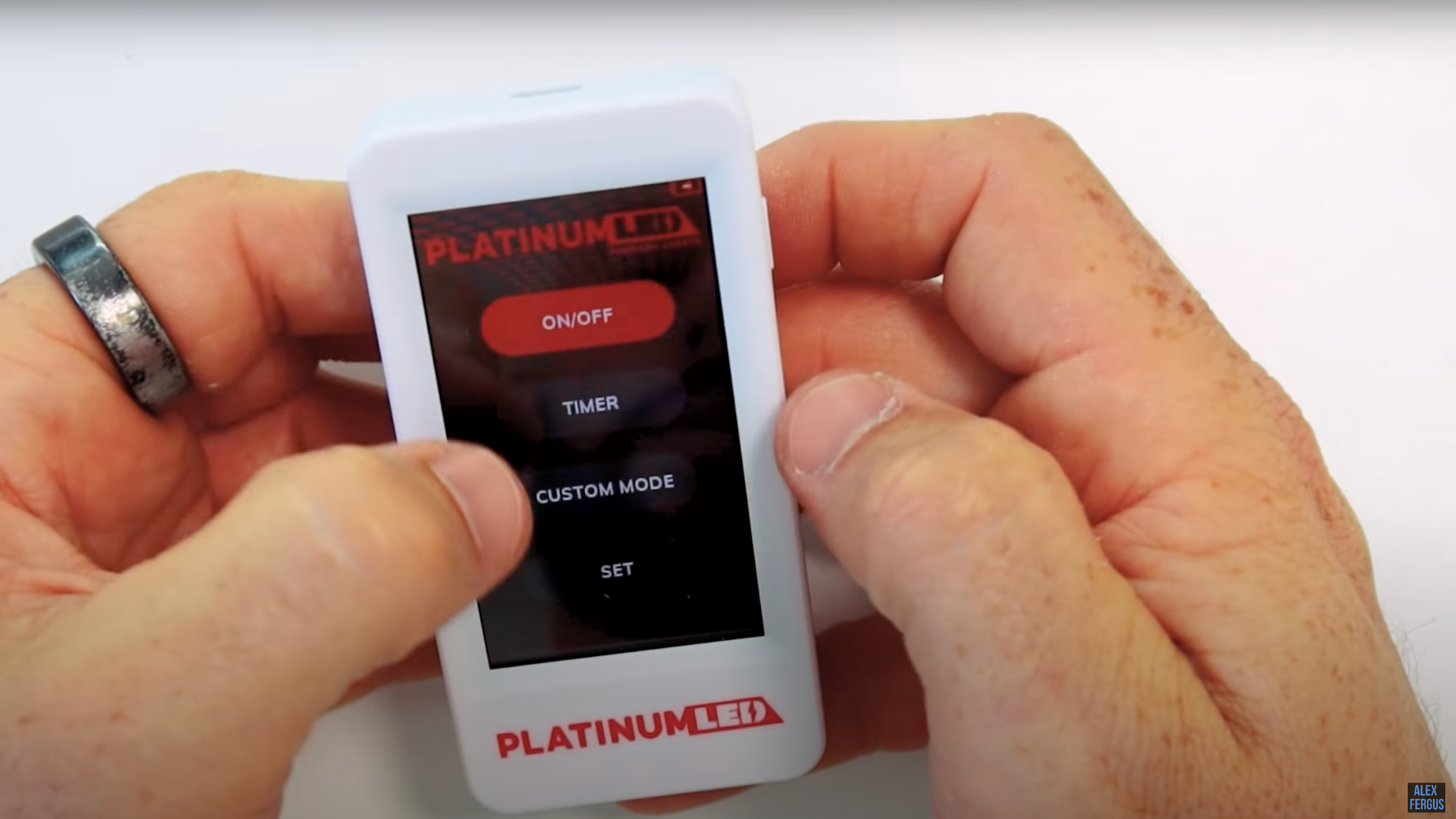
We all recall that basic on-off remote that came included with the seventh-gen panel. Luckily, it's back in action with the eighth-gen version. I've done dedicated reviews of their remotes.
Tech-savvy folks, you'll appreciate the more advanced controls available in the free app on your phone.
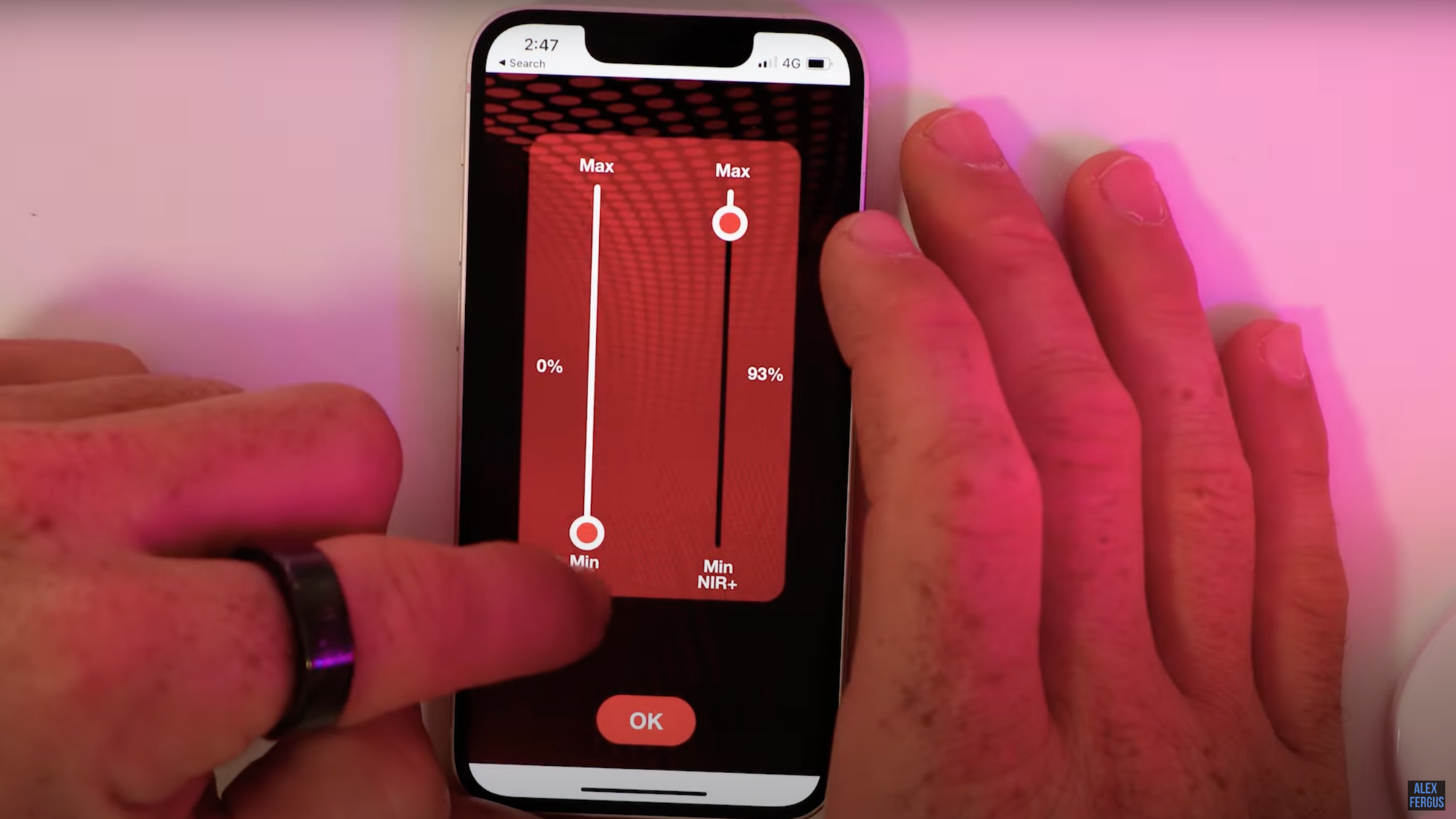
Plus, if you're after some next-level control, you can snag yourself their professional remote which remains the same. I've got detailed videos on your remote control options.
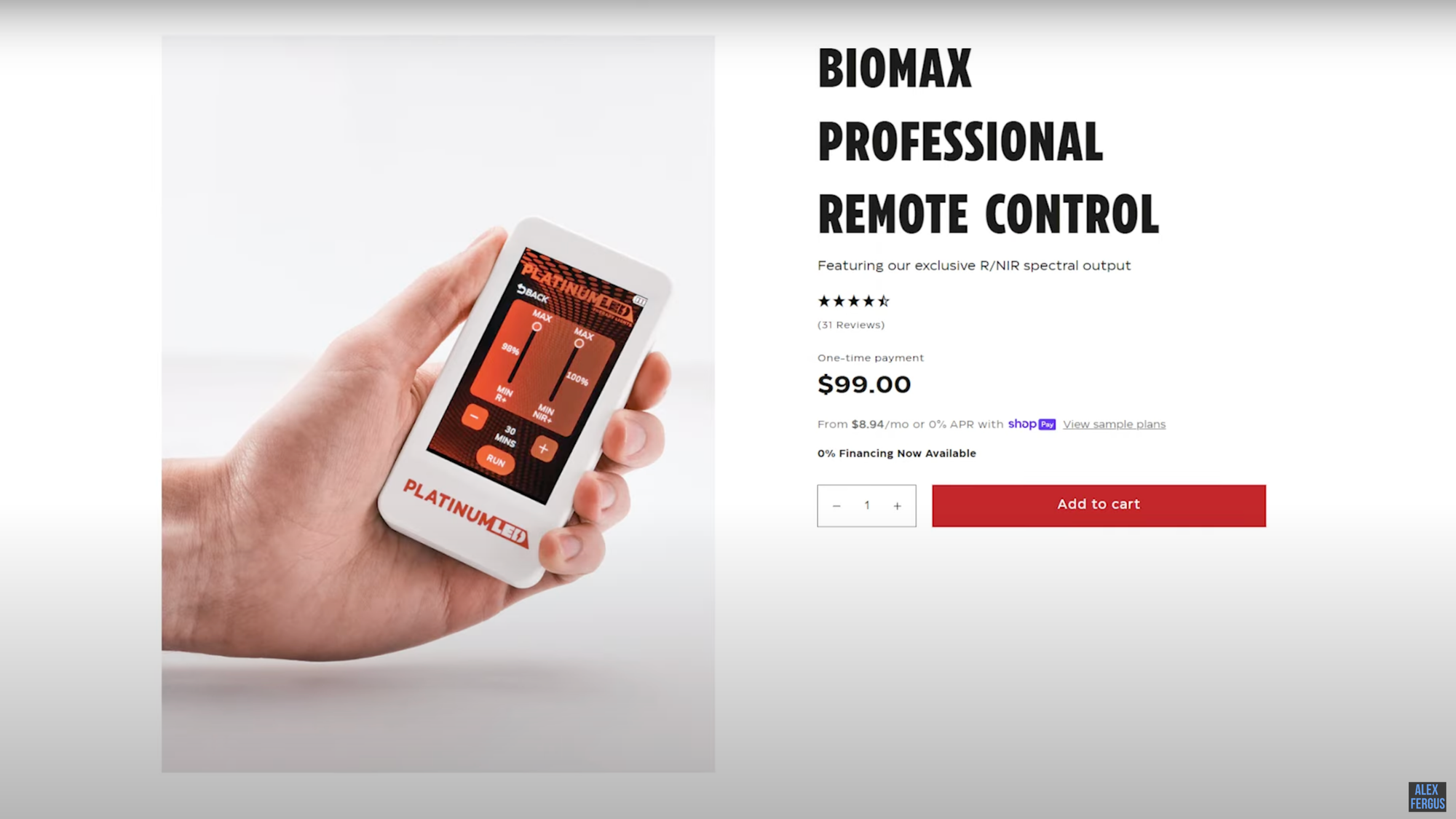
This most modern version also has a modified modular system with some brackets for strapping your multi-panel setup together that promises to be better than ever.
Now, let's talk turkey—how much is this premium panel gonna set you back? At the time of filming my YouTube review, the price was holding steady, but get ready for it to go up because this is going to be in high demand with all these neat features.
BioMax 900 in Context
This panel is the largest in PlatinumLED's BioMax line. With 300 LEDs, that's 50% more than the next size down. Weighing in at 33 pounds, it stands 36 inches tall, 12 across and 3 deep.
For comparison, the narrower BioMax 600 has 200 LEDs, weighs 22# and is 36" x 9" x 3". BioMax 450 is half as tall as the 900 with half as many LEDs at 150. It weighs 17# and is 19" x 12" x 3". The tabletop panel BioMax 300 has a third of the LEDs at 100, weighs 11# and is 19" x 9" x 3".
If you're contemplating one of the smaller ones, I've done plenty of reviews on those, but you will still find this review useful because much of the details about what's new and improved in this 8th generation also edition applies to the smaller ones too.
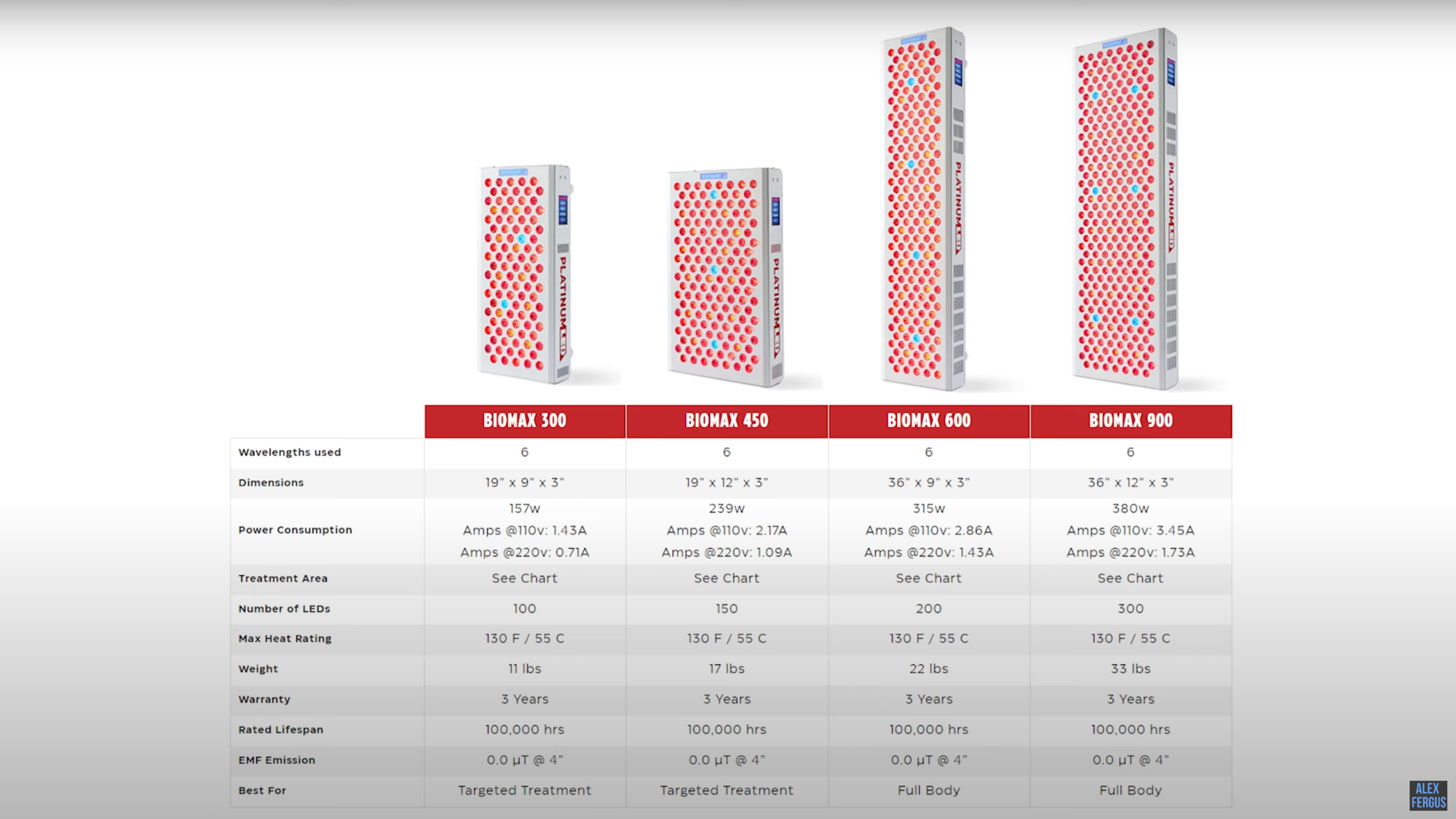
Wondering About Its Wavelengths?
Time to fire up the spectrometer to capture this wild new 7th wavelength! Twelve LED's representing 4% of its power are churning out this 1060nm therapeutic near infrared light.
It's an exciting wavelength with unique benefits that has the backing of some scientific research. Check out my blog article and my deep-dive videos to explore it more.
There are only half as many LEDs emitting the 480nm blue light with just 2% of the power going to those 6 LEDs. Remember, the blue LEDs can be disabled independently of the rest of the LEDs.
Five percent of the power is going to the 15 LEDs with 810nm near infrared (NIR) light. This is another wavelength with strong scientific support that you can read about in this blog article.
Next, we have the exact same percentage of power with 15 LEDs allocated to 830nm NIR light. Nine percent of the power is directed to the 27 LEDs giving off 630nm red light. These are two fairly common, classic wavelengths that have been around for awhile.
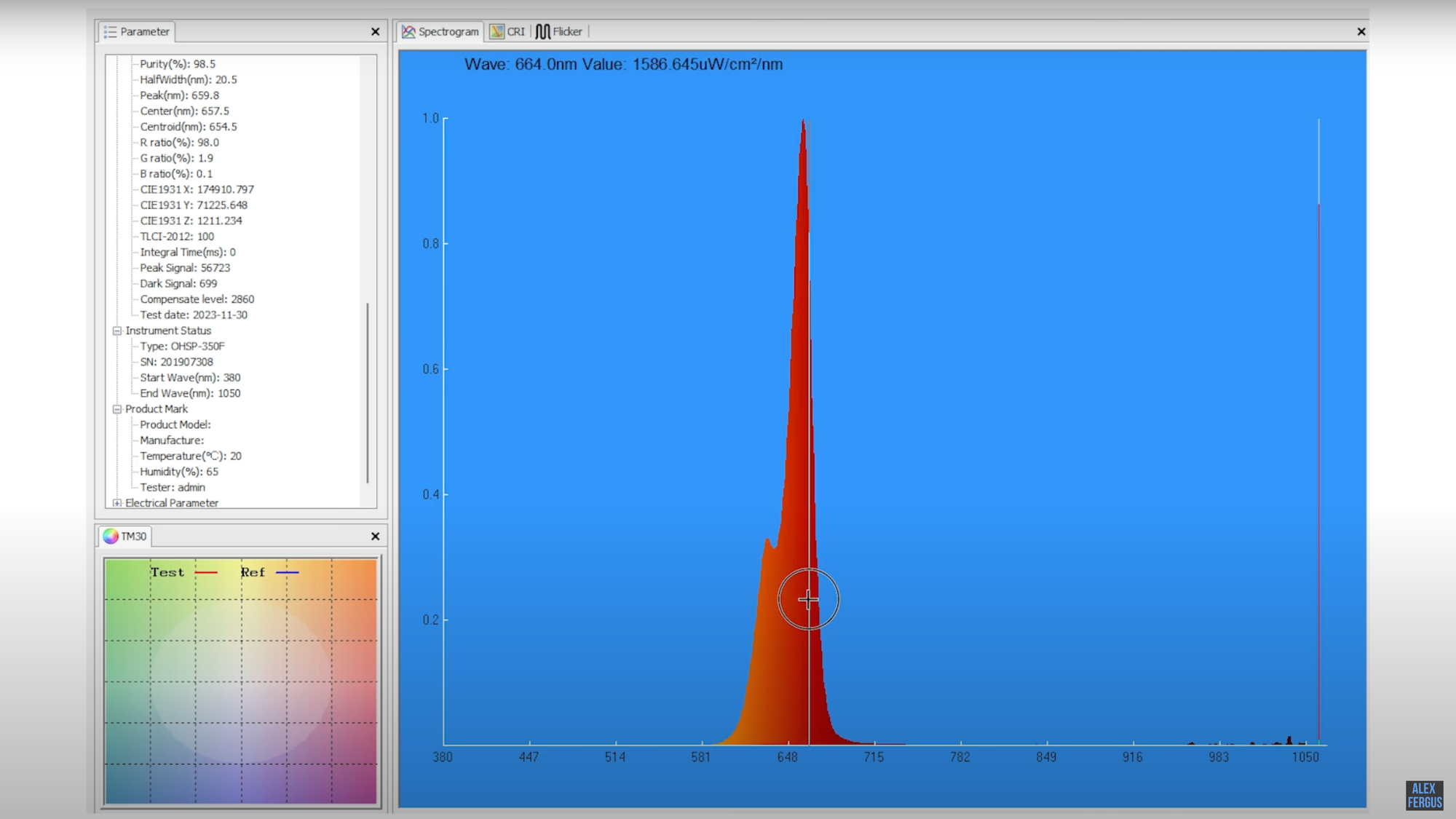
The two most traditional wavelengths that have been common to just about all panels from the get go are 660nm vibrant red light and 850nm invisible NIR light. Most of this panel has been reserved for those two old-school wavelengths.
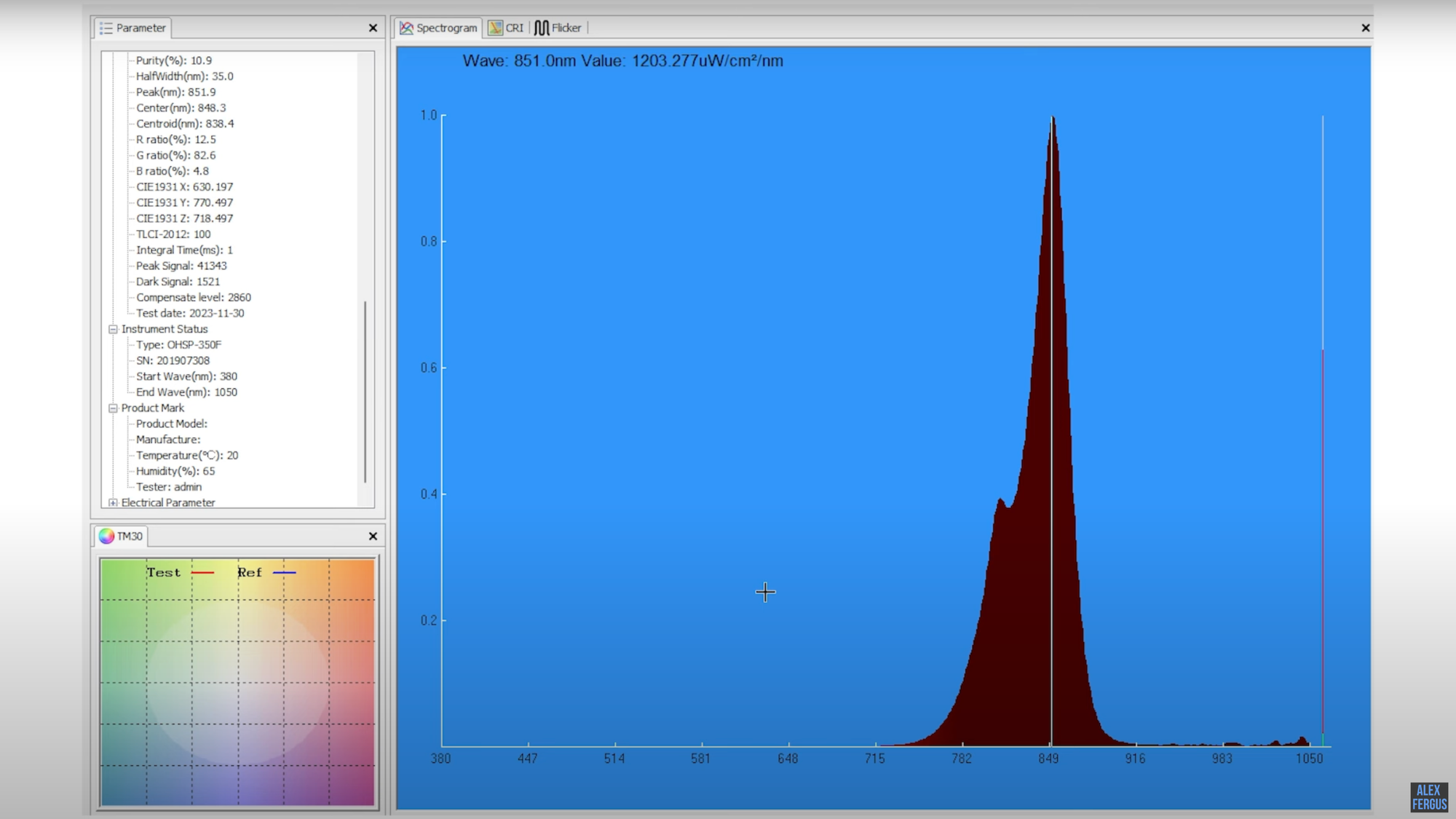
This massive peak is from one of the 108 LEDs representing 36% of the power radiating warm 850nm light. The greatest percentage of power at 39% goes to the 117 LEDs shining bright 660nm red light.
12 LEDs 4% are 1060nm near infrared (NIR)
15 LEDs 5% are 810nm NIR
15 LEDs 5% are 830nm NIR
27 LEDs 9% are 630nm red light
108 LEDs 36% are 850nm NIR
117 LEDs 39% are 660nm red light
100% of the panel's 300 LEDs in all have various benefits
Now you may be wondering, "Why the gap between the 810-850nm range before skipping right on past the 900s over to the newly introduced 1060nm NIR wavelength?"
Well, check this out guys because we are getting heaps of light in the 900s range that are all building up to the 1060nm wavelength. My spectrometer only goes up to 1050nm, so I have the white and pink line to the right of the peak to show approximately where 1060 would be if you envision the trending upwards slope continuing to that line.
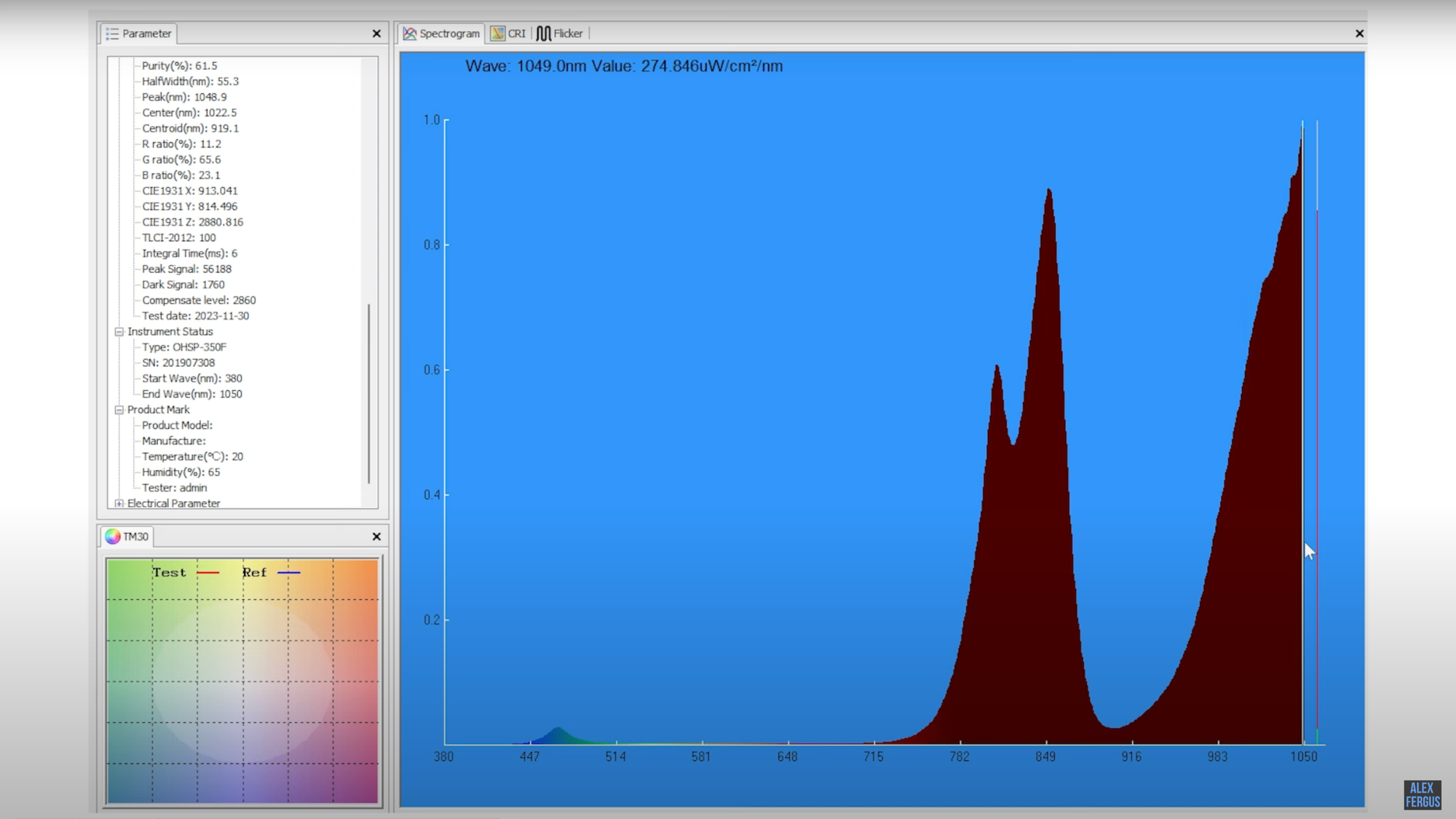
What goes up must come down, so on the back side of the 1060nm peak you might expect to be receiving additional wavelengths along the downward slope extending up into even longer wavelengths and maybe tapering off in the upper 1100s if the slope has mirror symmetry on both sides of the peak.
How It Works
Remember, none of the bulb lenses on these panels have any tint to them. It is not at all the same as the colored bulbs on your Christmas tree lights. Nor is it like looking at the world through tinted sunglasses. It's not even like basking in the glow of a pretty stained glass window.
This is entirely different because each of the 300 LEDs in this panel that are all powered by the cord in your home's wall outlet contain one of 7 different diode chips that are specifically designed to generate one of these uniquely beneficial wavelengths.
The clear lens covering domes protect the delicate diode inside each bulb. It makes the panel easier to clean and give it a nicer feel than if it just had 300 holes in the metal with an electronic chip mounted inside one.
The clear lens bulbs also help to evenly spread out each diode's wavelength to create a softer stream of light. Without those clear lens coverings, you would be getting a single piercing beam of light shooting out of each chip with intensely speckled coverage on your body.
It is truly impressive that we live in a day and age where diode chips can be finely tuned to create the exact wavelengths desired and that science keeps shedding more light on the benefits of each specific wavelength.
Performance Power
At the time of filming, PlatinumLED hadn't spilled the beans on their irradiance figures, so I couldn't crunch their numbers just yet. Typically, they use a solarmeter to take their measurements.
Solarmeters are not designed for measuring LED irradiance, so they give excessively high readings. That's why I bought my spectrometer for thousands of dollars so that I can measure all light therapy products to share my data with you.

I have reason to believe that PlatinumLED is working with some high-end equipment to get a much more accurate reading, so as soon as those figures drop, you can count on me to share them with you in my Facebook group and in my red light therapy newsletter so be sure to subscribe. It may be shared on our Light Therapy Insiders website as well.
In the meantime, let's talk power output. Relying on my trusty spectrometer, I was blown away by the peak power reading of a whopping 113 milliwatts per square centimeter (113mW/cm²).
But let's not get too carried away—what really matters is the average power output, which clocked in at a stellar 90.3mW/cm² at 6 inches. That's some serious power right there in its solo mode. This is the absolute highest average power output of any panel I've ever tested.
If you are running this while it is hooked up to a group of panels such as my BioMax 900 4-panel setup, the power is throttled to keep it from tripping the circuit. If it is part of a multi-panel setup, those figures would likely be reduced by 10–20%.
If you're thinking, "Hold your horses, Alex! I don't need that kind of horsepower in a panel."
To which I'd say, "The further away you stand, the lower the intensity." For instance, at 12 inches away, you would be receiving 75mW/cm² rather than the ninety at 6 inches.
Furthermore, if you don't want to stand further away, you can simply drop the intensity on the control panel by selecting any power intensity from 100% power all the way down to just 1% if you want. It's great that you've got options.
All in all, I came out with a total of 186 watts (W) of therapeutic light from this panel. Let's check out the metrics on my handy panel-comparison resource next.
Shopping Tool Power Standings
What I want to do is filter it by wall panels to get the top 36 here, and then we are going to sort by radiance from high to low. Straight away here at the top, you can see BioMax 900 8th gen 2024 at 90.3mW/cm². There's quite a gap down to the Hooga at 86mW/cm², and then the Rouge at 81mW/cm².
(Click HERE to access my shopping tool!)
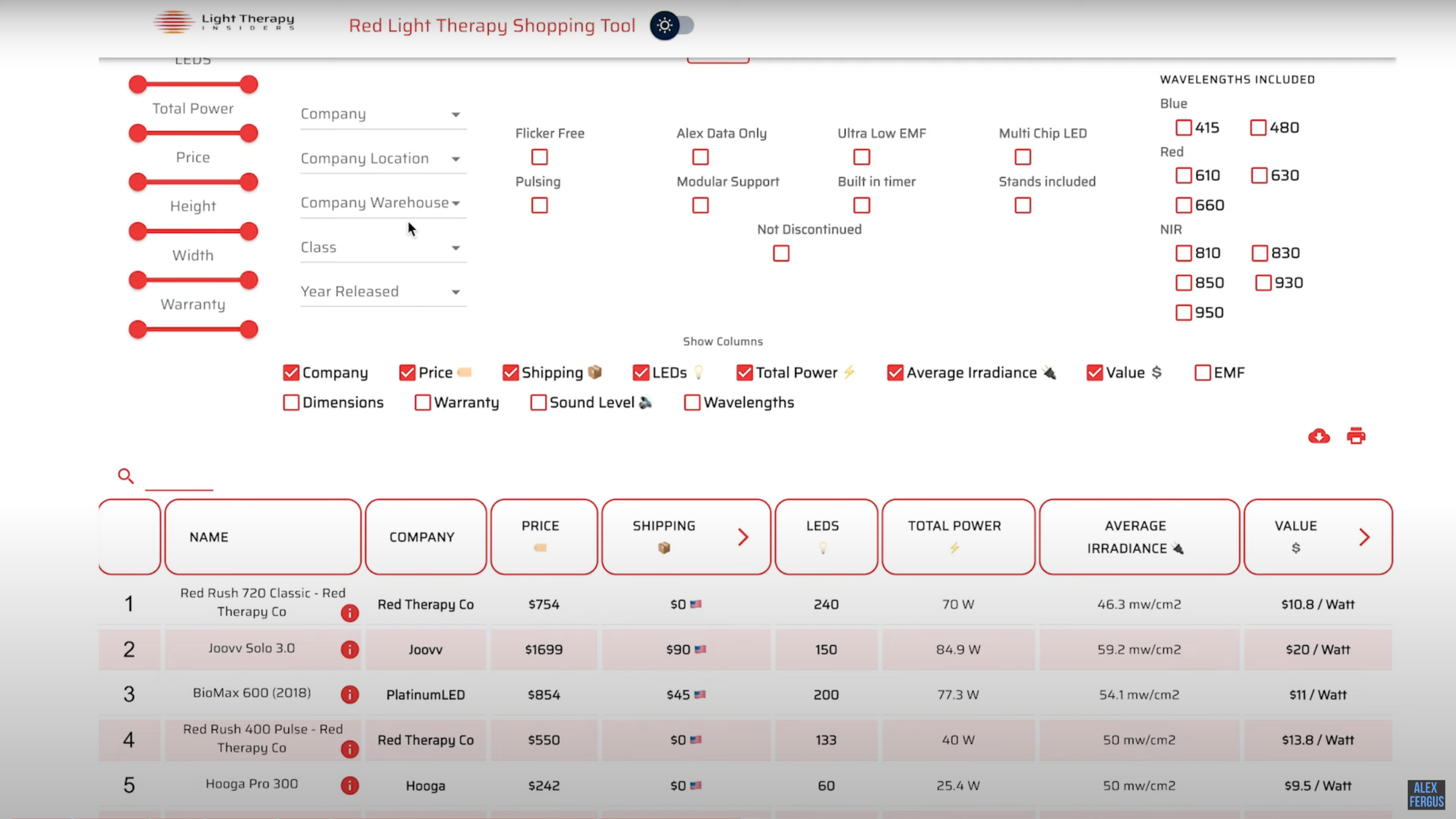
If we look at the 2023 version of PlatinumLED BioMax 900, that was 71mW/cm². Remember, that was throttled, somewhat similar to the BioMax 900 of 2021.
Now, let's look at it by total power again. We'll sort by high to low, and here we can see that PlatinumLED BioMax 900 comes in at 2nd place with 186 watts of raw total power. That's even higher than the Blue Light Mega at 168.8W.
Only the Mito Light MitoHacker 4.0 packs a more powerful punch at 216W of beneficial wavelengths. However, the MitoHacker 4.0 does have 108 more LEDs and costs more to boot.
Sound & EMF
The level of EMF (electric and magnetic fields) was good. There are no issues there. And listen, if you're interested in the sound of this panel putting out all this power, I measured the noise level at 49dB (decibels).
Price Rising
How much is the most powerful 300 LED panel on the market? At the time of filming my video review, you could get it for a retail price of $1,259.00.

The company website says: "PlatinumLED continues to witness an absolute explosion of orders shattering all previous records! The current demand for the newest Generation 8 BIOMAX is surpassing anything that we could have ever prepared for and we can't thank our global family of customers enough for the trust and support. All order are shipped in the chronological order that they are received in. The sooner an order is placed, the sooner an order will ship."

As I advised in my YouTube review, the price was bound to increase. Sure enough, it has gone up $40 in recent months, so don't forget to use my discount link to save 5% which is a savings of about $65 at the time of publishing this blog article.
Looks like BioMax 900 recently received a couple hundred more 5 star reviews from satisfied buyers between then and now. Congratulations on a job well done PlatinumLED!
Kudos to their website team for upping their game as well! That brand new red oval button in the bottom right corner lets you chat with PlatinumLED. Clicking on the pink button reveals it's on backorder until July 5, 2024 at the time of publishing. They add that it is first come, first serve.
If you're in the continental USA, you're in luck because shipping this big BioMax 900 panel to you is now free! International shipping will likely run somewhere between $60 to $200.
BioMax 900 has a 3-year warranty. It has a 60-day return period with a 20% restocking fee.
Calculating the value, Biomax 900 8th generation is $6.40 per watt of therapeutic light. That is the second best of all the wall panels I've tested to date.
The only one with a higher value was the Alibaba panel I bought direct from an overseas factory that was very basic panel. Feel free to check out my review on that panel or see how it compares in my 2024 epic comparison of 17 panels!
Stands & Accessories
Here's the rundown of all the extras you can buy to give you the best experience as you incorporate light therapy into your wellness routine. There's the professional remote for $99.
You can add the wheeled standing rack modular system for mobility and convenience which holds up to 3 panels wide and 2 high for anywhere from a 2 to 6-panel setup.
If you would like to lay down while using your panel, the horizontal rack holds one or two of the same type of panel width stacked end to end to make a long head to toe setup for $329.
You can get their wall mount bracket which will hold up to two panels joined together for a cost of $74.
They also offer you a rolling floor stand that can hold a single panel of any size locked into a vertical position a few inches off the floor for $139.
If you're looking for the most professional stand, the XL motorized horizontal stand can't be beat! For $769, you can experience the ultimate in comfort and convenience by wheeling 4 panels of any size over your bed or any other horizontal surface. It includes an optional remote control to conveniently lower and raise it.
I've done reviews on a lot of these stands including their two tabletop stands. Plus I'll be sharing a review of all the available mounting options for your panel.
Reasons It's Awesome
The generous size of this full body panel is especially nice. With a width of 12 inches, it's a winner. If you've seen my analysis of light coverage at various distances from the center, the results are clear: Wider is better!

If you have dreams of getting two BioMax 900s to go side by side, they are the perfect width to give you the most ideal shoulder to shoulder coverage.
It's quite impressive that BioMax 900 has 7 wavelengths! It's the first panel we've ever seen with that many. On top of that, the wavelengths that have been selected for inclusion are the cream of the crop!
That 1060nm wavelength does have a substantial amount of research behind it. It's best known for light therapy devices worn on the head.

Neuradiant 1070 uses wavelengths around that length for their brain health products that are specially shaped to deliver the therapeutic light to the curved surface of the head since light can penetrate through skull bones.
Outside on a sunny day, the equivalent of one candle lumen of light can penetrate through the skull which illuminates the brain sufficiently that you would hypothetically have enough light inside your brain to see to read a book.

This helmet style device uses select wavelengths that have been scientifically studied.
So I am excited about the addition of these 1060nm chip diodes. Those are a more expensive chip, so it's only natural that this higher-cost chip might be one reason they raised the panel's price.
It's currently only 4% of the light in this panel, but considering the full-body benefits it yields, I'd say it's off of a great start because 4% is clearly better than none, right?
I like it that it also has 2% blue light in an upper 400s range that can be disabled if desired.
Plus BioMax 900's power output is leading the market since no other wall device with 300 LEDs in this size and price-point range is cranking out the amount of beneficial light that this power house panel delivers!
Combine all those perks with the price, and you have one of the best value light therapy products available with that price point of $6.40 per watt which is quite extraordinary!
Not only is it a great value, but you're getting tons of additional features from the 7 wavelengths to the touchscreen control panel that lets you dim and adjust the intensity of the red lights and the near infrared wavelengths as well.
You also get a wide range of stand options sold by PlatinumLED so you know those will work perfectly with their products. Your panel comes with a high quality manual to help you get off to a great start. Some handy accessories are included such as a couple of cords.
Their complimentary pully system has always worked well for me over the years. Not only that, you get access to their cell phone app plus their free basic remote to boot.
It will give you peace of mind knowing you are buying from the PlatinumLED company since they have been developing and selling light therapy products since the early days, so they've got staying power.
Many light therapy companies don't have a phone number for customer support, but PlatinumLED is one of the few who do. It's a toll free phone number too. Their hours are from 9am to 5pm in the Pacific Time Zone from Monday through Friday. They are also connected to social media on Facebook, Instagram, LinkedIn, and Twitter.
The BioMax panels also have a special wireless connectivity system if you want to use multiple panels together. It's very easy to connect them and operate them all through a single control panel or remote control. Plus, you get a discount from PlatinumLED if you purchase multiple panels, and you can still use my link as well.
The Downsides
First up is the addition of blue light. Now, there are some benefits of blue light when it comes to skin health, circadian rhythm, and a few other benefits. I've interviewed Scott Kennedy CEO of LightpathLED who has discussed it. My site LightTherapyInsiders.com has published articles about blue light as well.
However, not everyone wants blue light. Thankfully, you can disable it if you don't want those blue LEDs running. Yet some people would still prefer a panel without blue light. They might say: If people want blue light, they could get a device exclusively dedicated to it for those specific purposes. I totally get it.
Remember though, even with those 6 blue light LEDs in this panel disabled, you're still getting a power figure higher than any other panel I've ever tested. When I took those irradiance readings, I turned off the blue light LEDs and just measured the red and near infrared rays.
Sure, people may wish they had 6 more LEDs of red or near infrared LEDs instead. Nevertheless, even with those blue LEDs in there, you're still getting more therapeutic red and near infrared wavelengths than from any other panel.
Another potential issue with the BioMax panels is that most of the light energy is concentrated in the 660 and 850nm wavelengths. Granted, you may be one of those people who still want to stick to these tried and true wavelengths.
Remember, I used a panel for many years that only had 660 and 850nm LEDs, and I had great results. However, we now know that these other wavelengths: 810nm, 630nm, and 1060nm are very effective for the body.
Naturally, some people want a panel with a greater proportion of energy going into these other wavelengths that are a smaller fraction of the BioMax panels. Those alternatives are out there. I'll share some with you in a moment.
PlatinumLED have stayed a bit more conservative here with 75% going to the two traditional wavelengths while 25% is split amongst the other 5 wavelengths. Some people may not like that.
Another drawback of the wavelengths being allocated this way is that you're not getting an equal blend of light. We saw that reflected on my spectrometer readings when I was trying to capture all 7 wavelengths at once which wasn't an easy feat. My spectrometer really had to hunt and peck for a single sweet spot that would show all seven on one screenshot.
Wherever I scanned across the panel, I always picked up the most common 660 and 850nm wavelengths. What this means is that you may have a spot on your body that is always being exposed to blue light unless you have those six LEDs disabled.
Although, another place on your body may never get blue light rays and only receives 1060nm near infrared waves. Meanwhile, another body location may be getting plenty of 810nm, yet missing out on those longer 1060nm waves as well as the blue rays in the 400nm range.
PlatinumLED take this into the equation and recommend users stand further than 6 inches away to get a better blend of light. That strategy works because of the amount of power this panel generates for you, but it's not the perfect solution.
Another option is to simply move around side to side and up and down to ensure those less common wavelengths get in contact with a variety of places on your body instead of always being stuck striking the same spot.
Other things to consider are the high international shipping costs which we are seeing with plenty of other companies too. If you live outside of America, this shipping fees may be reason to reconsider.
Not to mention, the return fees are rather steep. Granted, that may not deter users who are already sold on light therapy, but for new buyers that fee could pose a barrier to entry.
Lastly, you may like to know, there is no pulsing in PlatinumLED panels.
Should You Buy This Panel?
Well, if you want the panel with the greatest variety of wavelengths on the market, then yes! If you want a panel that has the highest power output, then go for it! If you want a panel that taps into the benefits of 1060nm wavelengths, then this is it!
If you want to buy a panel from a company that has been ruling the light therapy space since way back in the day and consistently comes out with winning panels that are feature-rich and well-priced, then they're going to be a good safe bet!
If you want panels that are easy to set up and use in solo mode or as a multi-panel setup linked together, then you're all set because this is where it's at for all that!

Finally, if you want to do what works for me and use the same panel that is part of my wellness routine, then join me in enjoying these BioMax 900 panels!
Comparison Shopping
Before heading to the checkout, you may be interested in my reviews of some additional top contenders for your consideration.
Check this out: Diesel XL Shortie by LightpathLED for $1,624 here (code ALEX saves).

You'll remember how two BioMax 900s side by side give you complete shoulder to shoulder coverage. Yet some people may only have space or funds for one panel in which the BioMax 900 would treat about half their back at a time.
This is where the Diesel XL Shortie comes into consideration. Yes, it's shorter for sure. It's a bit more expensive. And it's not as polished. Plus it only has three wavelengths.
However, it is wider than the BioMax 900. I've done a full review on that panel for you to peruse at your leisure.
Here's another panel to ponder: Rouge Pro G3 (code ALEX saves) which is the same width with a decent power output and it costs less.

However, it is limited to only the two traditional 660 and 850nm wavelengths. So you would be missing out on some of the extra perks that a BioMax 900 offers.
Don't miss this: Mitohacker 4.0 by Mito Light. If you're looking for something nice and wide with plenty of power, although fewer different wavelengths, yet still boasting a rich variety of rays and waves, get a load of this massive beast!

It's enormous stretching an expansive 16 inches across!
We are still running the Mito Light with 408 LEDs, but still, if you just want a giant panel with a lot more wavelength (7), here you go. But the Mito Light doesn't have your blue or your 1,060 nm light.

Another option to check out is the Block Blue Light Powerpanel Mega (code ALEX saves). The Mega has a similar size, similar touchscreen, good light coverage, and using dual-chip LEDs but you're not getting the unique wavelengths that the BioMax has. And, the Powerpanel Mega is a lot more expensive as well.
Now, if you're still confused, I recommend checking out the following videos:
And:
&
Comparing Power Output and Concluding Thoughts
Now, let's put these numbers into perspective. A quick glance at the data reveals that the BioMax 900 8th gen is sitting pretty at the top of the power charts. With a total therapeutic output of 186 watts, this panel is a force to be reckoned with.
I've gotta hand it to PlatinumLED—they've outdone themselves with the BioMax 900 8th generation. With a whole host of upgrades and enhancements, this panel is a game-changer in the world of red light therapy.
Who knows what the future holds? If PlatinumLED keeps up this momentum, the sky's the limit. But hey, enough from me—what are your thoughts on its unique new wavelength and amped up power output? Let me know in the comments below, and don't forget to join the conversations on our Facebook group for even more exclusive content.
Overall, I think this is an incredible panel with tons of changes over this past a year. The new unique wavelength, the reallocation of power, the new hanging system.
This panel is putting out an insane amount of power. I mean, 90.3 is just ridiculous. I don't know how much higher they can go.
What I will say is I'm super excited to see what the future holds for PlatinumLED with the velocity of their rapid rates of ongoing improvements. They are already leading the pack, but they continue pushing forward at an astounding pace to stay ahead of the game!
Thanks for joining me in unpacking all the info about BioMax 900 8th gen today. Until next time, cheers!
This Article's Products With Benefits:
✅ Buy a PlatinumLED BioMax 600 or 900 by using for a discount - UPDATE: no discount code is available, so you'll have to click the link
✅ To get a LightpathLED Diesel XL Shortie use code ALEX and get 5% off with the following link:
✅ If you want to get a Rouge Pro G3 panel then use code ALEX and this link:
✅ Mito Light Mitohacker 4.0 (In The EU) - get 5% OFF storewide by using code ALEX
✅ For a Block Blue Light panel use discount code ALEX and the following link:
Extra! Extra! Read All About It!
✅ Excel sheet for comparing this panel to the competition
✅ For my buyer's guide
✅ My team's blog about 1060nm and 1064nm wavelengths
✅ My red light therapy blog with many deep-dive articles
✅ Blue light versus red light therapy blog
Be In The Know With My YouTube Videos
✅ BioMax remotes review
✅ BioMax 300 review
✅ BioMax Motorized Stand review
✅ BioMax regular stands review
✅ Rouge Pro G3 review
✅ LightpathLED Diesel Shortie XL review
✅ Block Blue Light Powerpanel Mega review
✅ My red light testing methodology for reviews video
✅ Neuronic Neuradiant 1070 review
✅ Interview with Scott Kennedy of LightpathLED


